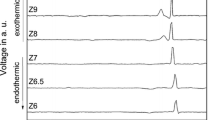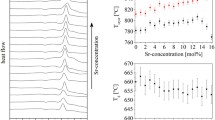Abstract
The microstructure of a translucent keatite solid–solution glass–ceramic (keatite s.s.) of the LAS-system (Li2O–Al2O3–SiO2) has been analyzed with SEM, AFM, XRF, XRD, and TEM. The glass–ceramic consists mainly of keatite s.s. with minor secondary phases such as zirconium titanate, gahnite and probably rutile. Furthermore the resistance to temperature differences (RTD) of this glass–ceramic was investigated. It is shown that, in spite of the relatively high coefficient of thermal expansion (CTE) of about 1 × 10−6 K−1, an improved RTD can be achieved by special ceramization treatment. With this, compressive stresses in the first 100 μm to 150 μm are induced. These stresses can presumably be contributed to a difference in CTE between the surface-near zone and the bulk. Said CTE difference is caused by chemical gradients of CTE-relevant elements, such as Zn, K, and supposedly additional alkali elements such as Li. These stresses are useful to increase the strength and application range of glass–ceramics based on keatite s.s.


















Similar content being viewed by others
Notes
Because RTD stands for “resistance to temperature difference” it describes strictly speaking a strength [MPa]. Nevertheless according to Eq. (4) here the breakage-temperature [°C] is used as a measure of RTD.
The bars in the average grain-size diagram show the cross-sectional distribution, not the error of the analysis.
Abbreviations
- LAS:
-
Li2O–Al2O3–SiO2
- HQ:
-
High-quartz
- CTE:
-
Coefficient of Thermal Expansion
- RTD:
-
Resistance to Temperature Differences
- s.s.:
-
solid–solution
- SEM:
-
Scanning-Electron Microscopy
- TEM:
-
Transmission Electron Microscopy
- EDX:
-
Energy Dispersive X-ray Spectroscopy
- XRF:
-
X-ray Fluorescence Analysis
- XRD:
-
X-ray Diffraction
- RS-XRD:
-
Residual-Stress X-ray Diffraction
References
Scheidler H, Rodek E (1989) Ceram Bulletin 68(11): 1926
Allersma T (1980) Patent US 4,218, 512
Pannhorst W, Wichelhaus W (1983) Proc. 13th Int. Congr. On glass, 56K: 572
Zimmer J (1997) PhD Thesis, Uni Würzburg
Bach H (ed.) (1995) Low thermal expansion glass ceramics, Springer
Lawn BR, Fuller ER (1975) J Mater Sci 10: 2016
Evans AG, Proc. 11th Symp. on fracture Mechanics, ASTM 678, 83 (1978)
Anstis GR, et al. (1981) J Am Ceram Soc 64(9): 533
Munz D, Fett T (1989) Mechanisches Verhalten keramischer Werkstoffe, Springer
Lawn BR, Fuller ER (1984) J Mater Sci 19: 4061
Gruninger MF, et al. (1987) J Am Ceram Soc 70(5): 344
Hummel FA (1951) J Am Ceram Soc 34(8): 235
Fukasawa T, Iwatsuki M, Yamaguchi K (1973) Bunseki Kagaku 22(6): 745
Arnault L, Gerland M, Rivière A (2000) J Mater Sci 35: 2331
Author information
Authors and Affiliations
Corresponding author
Rights and permissions
About this article
Cite this article
Roos, C., Becker, O. & Siebers, F. Microstructure and stresses in a keatite solid–solution glass–ceramic. J Mater Sci 42, 50–58 (2007). https://doi.org/10.1007/s10853-006-1045-0
Received:
Accepted:
Published:
Issue Date:
DOI: https://doi.org/10.1007/s10853-006-1045-0




